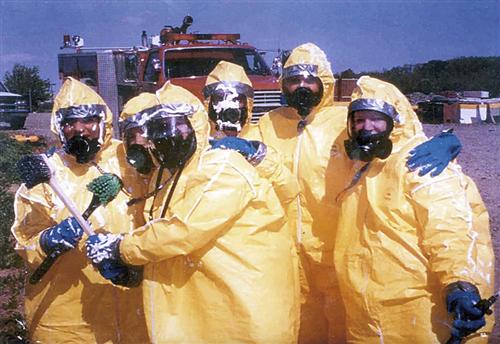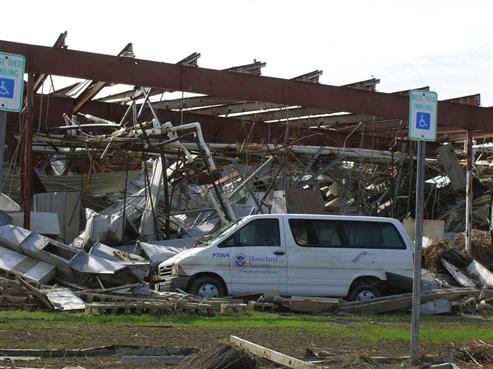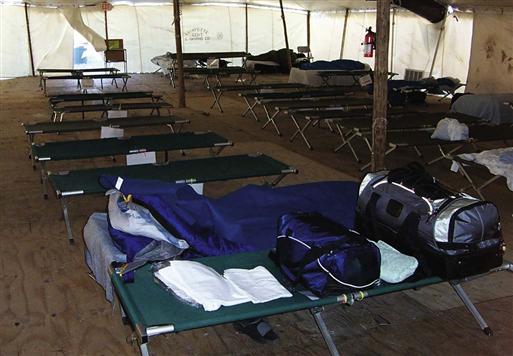Linda Laskowski-Jones
Concepts of Emergency and Disaster Preparedness
Learning Outcomes
Safe and Effective Care Environment
1 Apply principles of triage to prioritize care delivery in a disaster situation.
2 Identify the roles of the nurse in emergency preparedness and response.
3 Compare the key personnel roles in an emergency preparedness and response plan.
4 Describe the components of an emergency preparedness and response plan.
5 Develop a personal emergency preparedness plan.
6 Identify the type of patients to recommend for hospital discharge in a disaster situation.
Psychosocial Integrity
7 Assess survivors for ability to adapt to the effects of disaster changes or traumatic events.
8 Provide support to the person and/or family in coping with life changes resulting from a disaster.

http://evolve.elsevier.com/Iggy/
Answer Key for NCLEX Examination Challenges and Decision-Making Challenges
Audio Glossary
Key Points
Review Questions for the NCLEX® Examination
A disaster is commonly defined as an event in which illness or injuries exceed resource capabilities of a health care facility or community due to destruction and devastation. It can be either an internal or an external disaster.
Types of Disasters
An internal disaster is any event inside a health care facility or campus that could endanger patients or staff. The event creates a need for evacuation or relocation. It often requires extra personnel and the activation of the facility’s emergency preparedness and response plan (also called an emergency management plan). Examples of potential internal disasters include fire, explosion, and violence. Each health care facility develops policies and procedures for preventing these events through an organized security management plan. The most important outcome for any internal disaster is to maintain patient, staff, and visitor safety.
An external disaster is any event outside the health care facility or campus, somewhere in the community, which requires the activation of the facility’s emergency management plan. The number of facility staff is not adequate for the incoming emergency department (ED) patients. External disasters can be either natural, such as a hurricane, or technologic, such as a biologic terror attack.
Both internal and external disasters can result in many casualties, including death. Multi-casualty and mass casualty (disaster) events are not the same. The main difference is based on the scope and scale of the incident, considering the number and severity of victims or casualties involved. Both require specific response plans to activate necessary resources. In general, a multi-casualty event can be managed by a hospital using local resources; a mass casualty event overwhelms local medical capabilities and may require the collaboration of multiple agencies and health care facilities to handle the crisis (Smith, 2010). State, regional, and/or national resources may be needed to support the areas affected by the event. Trauma centers have a special role in all emergency preparedness activities because they provide a critical level of expertise in complex injury management.
To maintain ongoing disaster preparedness, hospital personnel participate in emergency training and drills regularly. In the United States, The Joint Commission (2008) mandates that hospitals have an emergency preparedness plan that is tested through drills or actual participation in a real event at least twice yearly. One of the drills or events must involve community-wide resources and an influx of actual or simulated patients to assess the ability of collaborative efforts and command structures. In addition, accredited health care organizations are required to take an “all-hazards approach” to disaster planning. Using this approach, preparedness activities must address all credible threats to the community that could result in a disaster situation. Disaster drills, then, are ideally planned based on a risk assessment that identifies the events most likely to occur in a particular community. For example, a flood is more likely in the Gulf of Mexico and an avalanche is more likely in ski areas of the Rocky Mountains.
Hospitals are not the only health care agencies that are required to practice disaster drills. Nursing homes and other long-term care (LTC) facilities are also mandated to have annual drills to prepare for mass casualty events. Part of the response plan must include a method for evacuation of residents from the facility in a timely and safe manner.
An evacuation plan is also part of fire prevention and preparedness plans for health care facilities. The Life Safety Code® published by the National Fire Protection Association provides guidelines for building construction, design, maintenance, and evacuation. Every health care facility is required to practice at least one fire drill or actual fire response once a year. Patient evacuation is not required if the event is a drill. All facility personnel are mandated to have training on fire prevention and responsiveness each year. Chart 12-1 lists general guidelines for fire responsiveness and building evacuation to ensure safety.
Impact of Recent External Disasters
The events of September 11, 2001, changed hospital and community disaster planning efforts. With the shocking terrorist attacks on the Twin Towers of the World Trade Center and the Pentagon and the actual and perceived threat of domestic terrorism including anthrax exposure that followed, hospital emergency preparedness concepts became much more fully integrated into the daily operations of emergency departments (EDs) by necessity. Weapons of mass destruction (WMD) rapidly became the focus of public health risk.
The term “NBC” was coined to describe nuclear, biologic, and chemical threats. In response, emergency medical services (EMS) agencies and hospitals upgraded their decontamination facilities, equipment, and all levels of personal protective gear to better protect staff. ED physician and nursing staff underwent hazardous materials (HAZMAT) training and learned how to recognize patterns of illness in patients who present for treatment that potentially indicate biologic terrorism agents, such as anthrax or smallpox (Fig. 12-1). Protocols for the pharmacologic treatment of infectious disease agents, as well as stockpiles of antibiotics and nerve agent antidotes, were made readily available.
The most immediate outcome of improving emergency preparedness after September 11 is that the ability to competently handle the more typical multi-casualty or mass casualty incident such as a bus crash, tornado, or building collapse has been greatly improved in many communities. However, disaster situations can still exceed the scope of usual day-to-day crisis operations, pointing to the necessity of well-defined regional and national emergency preparedness plans.
In 2005, Hurricane Katrina made landfall in Louisiana and other Gulf states as a category-4 storm and caused more than 1000 deaths and devastating environmental and property damage (Fig. 12-2). Volunteers from all over the United States, as well as local, regional, and federal agencies, took part in the large-scale disaster evacuation, rescue, and relief effort that severely challenged available resources and established disaster plans. Critical systems failed and were eventually re-established through coordination with multiple agencies and people to ensure that the most basic human needs were met (Fig. 12-3). Hurricane Katrina overwhelmed the existing emergency care system and caused the mobilization of a national mutual aid response on a level that had not been experienced in recent U.S. history.
Lessons learned from Hurricane Katrina, as well as recent worldwide incidents such as the earthquake in Haiti, tsunamis, and terrorist attacks, enable improved preparation and coordination of efforts that are beneficial for future disasters. These insights also can be applied to health care facility and community agency plans for pandemic infections, including influenza.
A pandemic leads a vast number of people to seek medical care, even the “worried well.” Though not yet ill, the “worried well” want evaluation, preventive treatment, or reassurance from a health care provider. A pandemic influenza outbreak, such as 2009-2010 swine flu outbreak caused by the H1N1 virus, raised significant concerns that the resource capabilities of the entire health care system could be overwhelmed and that community systems and critical supply chains could be severely damaged. Worker illness, absenteeism, and personal choices to remain quarantined to avoid being exposed to the illness negatively affect the number of health care staff available to care for patients. Fortunately, because of widespread vaccination programs and public information campaigns, the swine flu pandemic of 2009-2010 was well managed. Concern remains that avian influenza A strain (H5N1), also known as “bird flu,” could pose a global pandemic threat if a gene mutation occurs to allow human-to-human spread. Because of the mass casualty nature of pandemic influenza, emergency preparedness planners must incorporate strategies to handle an influx of ill patients into the system as part of ongoing disaster readiness. Quarantine of selected nursing units or the entire hospital could become necessary, prompting closure until the risk has passed.
Common to all mass casualty events, the desired outcome of emergency preparedness is to outline ways to meet the extraordinary need for hospital beds, staff, drugs, personal protective equipment (PPE), supplies, and medical devices, such as mechanical ventilators (Casani & Romanosky, 2006). The U.S. government stockpiles critical equipment and supplies in case they are needed for a pandemic influenza outbreak. In addition, the Food and Drug Administration (FDA) approved the first vaccine to protect humans against H5N1 avian influenza virus (see Chapter 25 for more information on emerging infections). Each state has its own specific emergency preparedness plan for pandemic influenza, including who would receive vaccines in a mass casualty event. Most of these plans are posted on the Internet.
Emergency Preparedness and Response
Mass Casualty Triage
Triage Process
A key process in any multi-casualty or mass casualty response is effective triage to rapidly sort ill or injured patients into priority categories based on their acuity and survival potential.
Triage functions may be performed by EMS providers in the field, such as:
• Emergency medical technicians (EMTs) and paramedics
• Nurse and physician hospital teams to assess and reassess incoming patients
Before going to the incident in the field, nurses, physicians, and support staff must have adequate training to prepare them to recognize the risks in an unstable environment (Laskowski-Jones, 2010). Such risks can include the potential for structural collapse, becoming the secondary target of a terrorist attack, interpersonal violence in unsecured locales, and working in an environment in which contagious diseases and natural hazards are common (e.g., poisonous snake bites and mosquito-borne illnesses). Disaster workers must take measures such as obtaining prophylactic medications and vaccinations, having a personal evacuation plan, and ensuring access to necessary supplies and protective equipment so that they do not become victims as well.
The National Disaster Life Support Foundation offers Basic Disaster Life Support and Advanced Disaster Life Support training courses that include all essential aspects of disaster response and management. They include the core competencies of disaster management to all levels of health care professionals (Subbarao et al., 2008). In addition, the Federal Emergency Management Agency (FEMA) provides Community Emergency Response Team (CERT) training so that people are better prepared for disasters and are able to respond more self-sufficiently to incidents and hazard situations in their own communities. These courses include mass casualty triage education.
Triage Method
An important point to recognize is that triage concepts in a mass casualty incident differ from the “civilian triage” methods discussed in Chapter 10 that are practiced during usual emergency department operations (Table 12-1). Although disaster triage practices can vary widely based on local EMS protocols, some concepts are fairly universal. Most mass casualty response teams both in the field (at the disaster site) and in the hospital setting use a disaster triage tag system that categorizes triage priority by color and number (Smith, 2010):
• Emergent (class I) patients are identified with a red tag.
• Patients who can wait a short time for care (class II) are marked with a yellow tag.
• Nonurgent or “walking wounded” (class III) patients are given a green tag.
• Patients who are expected to die or are dead are issued a black tag (class IV).
TABLE 12-1
COMPARISON OF TRIAGE UNDER USUAL VERSUS MASS CASUALTY CONDITIONS
| TRIAGE UNDER USUAL CONDITIONS | TRIAGE UNDER MASS CASUALTY CONDITIONS |
| Emergent (immediate threat to life) | Emergent or class I (red tag) (immediate threat to life) |
| Urgent (major injuries that require immediate treatment) | Urgent or class II (yellow tag) (major injuries that require treatment) |
| Nonurgent (minor injuries that do not require immediate treatment) | Nonurgent or class III (green tag) (minor injuries that do not require immediate treatment) |
| Does not apply | Expectant or class IV (black tag) (expected and allowed to die) |
In general, red-tagged patients have immediate threats to life, such as airway obstruction or shock, and require immediate attention. Yellow-tagged patients have major injuries, such as open fractures with a distal pulse and large wounds that need treatment within 30 minutes to 2 hours. Green-tagged patients have minor injuries that can be managed in a delayed fashion, generally more than 2 hours. Examples of green-tag injuries include closed fractures, sprains, strains, abrasions, and contusions.
The green-tagged patients are often referred to as the “walking wounded”; they may actually evacuate themselves from the mass casualty scene and go to the hospital in a private vehicle. Green-tagged patients usually make up the greatest number in most large-scale multi-casualty situations. Therefore they can overwhelm the system if provisions are not made to handle them as part of the disaster plan. Also, because they often come to the hospital on their own, the hospital may not be able to determine how many actual casualties will arrive. A related concern is that green-tagged patients who self-transport may unknowingly carry contaminants from a nuclear, biologic, or chemical incident into the hospital environment with potentially disastrous consequences. ED staff must anticipate these issues and devise emergency response plans accordingly, including appropriate decontamination measures.






